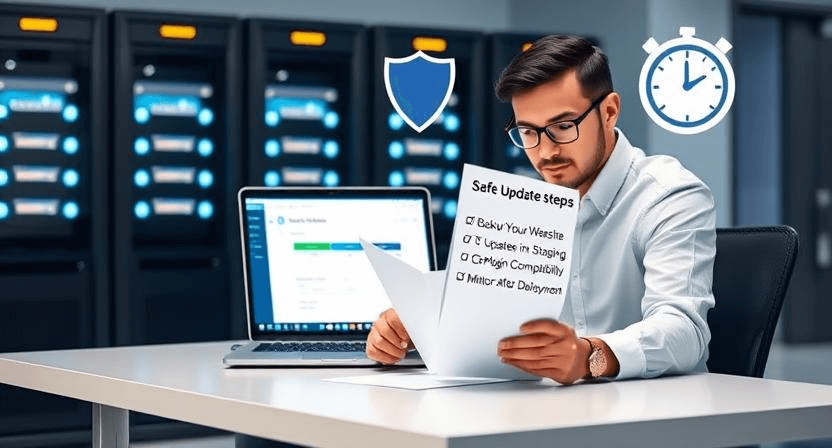How to Perform a Complete Website Security Audit

Website security is crucial for protecting your business, customers, and data from cyber threats. A complete website security audit helps identify vulnerabilities, improve defenses, and ensure compliance with security best practices. This step-by-step guide walks you through a detailed website security audit process.
1. Backup Your Website
Before starting any audit, ensure you have a full backup of your website. This prevents data loss in case any issues arise during the audit process.
- Use your web hosting provider’s backup service or a plugin like UpdraftPlus for WordPress.
- Ensure both files and databases are backed up and stored in a secure location.
- Download a copy of your backup to an external drive or cloud storage.
- Verify that your backup can be restored successfully by performing a test restoration.
- Schedule regular backups to automate the process and reduce risks.
2. Update Software and Plugins
Outdated software is a common security risk. Hackers exploit known vulnerabilities in outdated CMS versions, plugins, and themes.
- Ensure your content management system (CMS) is running the latest version.
- Update all plugins, themes, and third-party software.
- Check for deprecated plugins or themes and replace them with secure alternatives.
- Enable automatic updates if supported by your CMS to keep software up to date.
- Remove unused plugins and themes to reduce security risks. Read more in our Best Practices for Updating WordPress and Plugins guide.
3. Scan for Malware and Vulnerabilities
Perform a deep scan to detect malware, security vulnerabilities, and potential threats.
- Use tools like Sucuri, Wordfence, or MalCare for a full malware scan.
- Check for unauthorized file modifications or suspicious code in core files.
- Review server logs for unusual activity that might indicate a breach.
- Inspect your website for hidden iframes, malicious redirects, or injected scripts.
- Take immediate action if any malware or threats are detected.
4. Review User Accounts and Permissions
Unauthorized access is a major security concern. Regularly review user accounts to ensure only authorized personnel have access.
- Audit all user accounts and remove inactive or suspicious accounts.
- Ensure users follow the principle of least privilege (PoLP) – grant access only when necessary.
- Enforce strong passwords with a password policy and two-factor authentication (2FA).
- Monitor login attempts for brute force attacks and restrict failed login attempts.
- Update user roles and permissions to align with current security policies.
5. Secure Your Website with HTTPS
An SSL certificate encrypts data between your website and users, preventing data interception.
- Check if your website is using HTTPS and an active SSL certificate.
- Use tools like SSL Labs to verify the strength of your SSL encryption.
- Redirect all HTTP traffic to HTTPS using a 301 redirect.
- Update internal links and scripts to use HTTPS instead of HTTP.
- Monitor SSL certificate expiry dates and renew them on time.
6. Check File Permissions
Incorrect file permissions can expose sensitive files to hackers.
- Ensure directory permissions are set to 755 and file permissions to 644.
- Restrict access to critical files like
wp-config.phpand.htaccess. - Disable file editing within the CMS by adding
define('DISALLOW_FILE_EDIT', true);to the config file. - Use a security plugin to monitor unauthorized file modifications.
- Regularly audit file and folder permissions to minimize security risks.
7. Protect Against Brute Force Attacks
Brute force attacks attempt to guess login credentials through repeated attempts.
- Limit login attempts to block repeated failed logins.
- Enable two-factor authentication (2FA) for all admin accounts.
- Change default login URLs (e.g., for WordPress, rename
/wp-admin). - Use strong, unique passwords for all accounts.
- Monitor and block suspicious IPs using security plugins or server settings.
8. Secure Your Database
Database vulnerabilities can expose sensitive user data and credentials.
- Change default database prefixes to prevent SQL injection attacks.
- Restrict database user privileges to only necessary functions.
- Enable regular database backups and store them securely.
- Use a firewall to block unauthorized database access.
- Encrypt sensitive data stored in the database.
9. Set Up Security Monitoring
Continuous monitoring helps detect threats early and prevent attacks.
- Use security plugins like Wordfence or Sucuri for real-time monitoring.
- Enable email alerts for security threats and login attempts.
- Monitor server logs and traffic for unusual activity.
- Check for unauthorized changes to website files.
- Schedule periodic security audits to keep your site secure.
Conclusion
Conducting a comprehensive website security audit is essential for protecting your business from cyber threats. Regular audits help identify vulnerabilities, strengthen defenses, and maintain trust with users. Follow this step-by-step guide to ensure your website remains secure.
Need professional assistance? Contact WebCareSG for expert security services.
Related WebCare Solutions
How to Fix Website Downtime & Server Errors (500, 502, 503)
Learn how to diagnose and fix common server errors (500, 502, 503) to restore website functionality.
Essential Website Metrics Every Business Owner Should Monitor
Learn about the most critical website metrics every business owner should track to ensure online success. Understand how to analyze data for better decision-making.
How to Update Your Website Without Breaking It
Learn essential steps to update your website safely and efficiently, minimizing risks and ensuring a seamless user experience.
Ready to get started?
Focus on your business while we fix your website. Contact WebCareSG today for fast, reliable solutions!
Whatsapp us on


